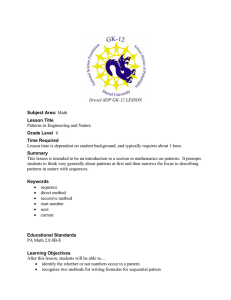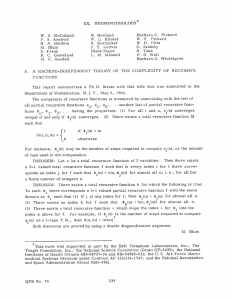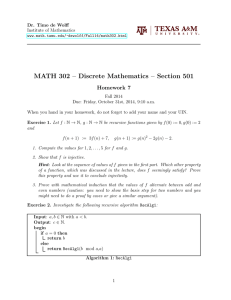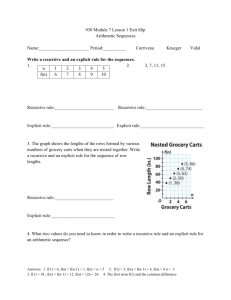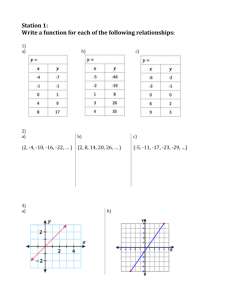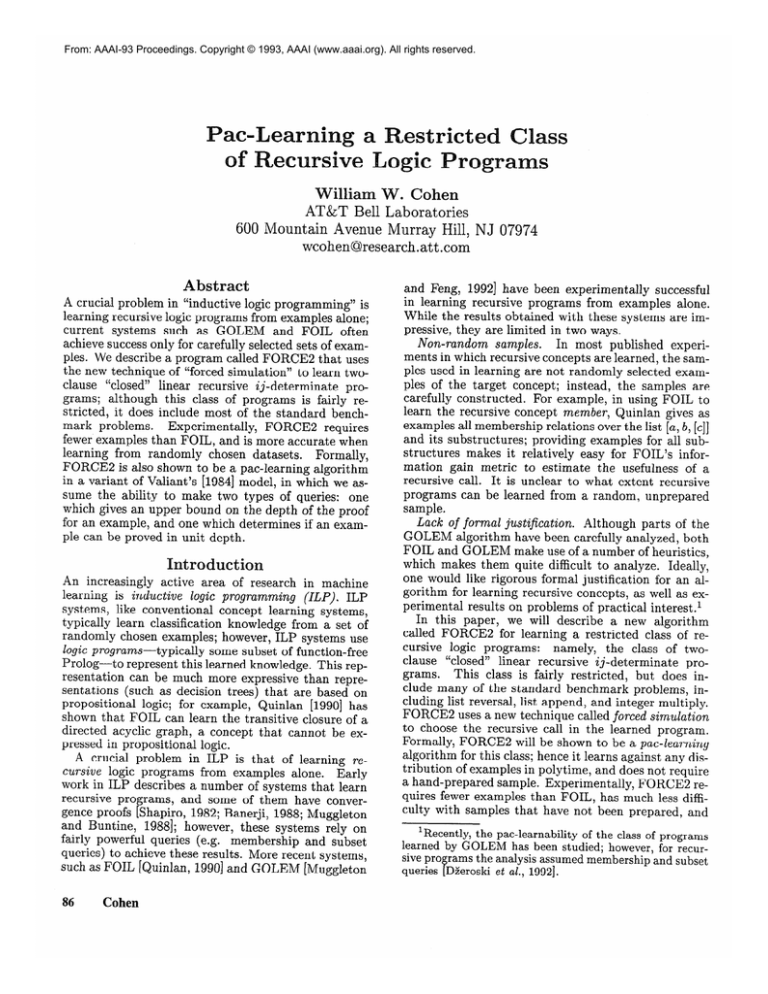
From: AAAI-93 Proceedings. Copyright © 1993, AAAI (www.aaai.org). All rights reserved.
William W. Cohen
AT&T Bell Laboratories
600 Mountain Avenue Murray Hill, NJ 07974
wcohen@research.att.com
Abstract
A crucial problem in “inductive logic programming”
is
learning recursive logic programs from examples alone;
current
systems such as GOLEM
and FOIL often
achieve success only for carefully selected sets of examples. We describe a program called FORCE2 that uses
the new technique of “forced simulation”
to learn twoclause “closed” linear recursive
ij-determinate
programs; although
this class of programs
is fairly restricted, it does include most of the standard
benchmark problems.
Experimentally,
FORCE2
requires
fewer examples than FOIL, and is more accurate when
learning from randomly
chosen datasets.
Formally,
FORCE2 is also shown to be a pat-learning
algorithm
in a variant of Valiant’s [1984] model, in which we assume the ability to make two types of queries:
one
which gives an upper bound on the depth of the proof
for an example, and one which determines
if an example can be proved in unit depth.
Introduction
An increasingly
active area of research in machine
learning
is inductive logic programming (ILP). ILP
systems, like conventional
concept learning systems,
typically learn classification
knowledge from a set of
randomly chosen examples; however, ILP systems use
logic programs-typically
some subset of function-free
Prolog-to
represent this learned knowledge. This representation
can be much more expressive than representations
(such as decision trees) that are based on
propositional
logic; for example,
Quinlan
[1990] has
shown that FOIL can learn the transitive
closure of a
directed acyclic graph, a concept that cannot be expressed in propositional
logic.
A crucial problem in ILP is that of learning
recursive logic programs from examples alone.
Early
work in ILP describes a number of systems that learn
recursive programs,
and some of them have convergence proofs [Shapiro, 1982; Banerji, 1988; Muggleton
and Buntine,
19881; however, these systems rely on
fairly powerful queries (e.g. membership
and subset
queries) to achieve these results. More recent systems,
such as FOIL [Quinlan, 19901 and GOLEM [Muggleton
86
Cohen
and Feng, 19921 have been experimentally
successful
in learning recursive programs from examples alone.
While the results obtained with these systems are impressive, they are limited in two ways.
Non-random samples. In most published
experiments in which recursive concepts are learned, the samples used in learning are not randomly selected examples of the target concept;
instead,
the samples are
carefully constructed.
For example, in using FOIL to
learn the recursive concept member, Quinlan gives as
examples all membership
relations over the list [a, b, [cl]
and its substructures;
providing examples for all substructures
makes it relatively
easy for FOIL’s information gain metric to estimate
the usefulness
of a
recursive call. It is unclear to what extent recursive
programs can be learned from a random, unprepared
sample.
Lack of formal justification. Although parts of the
GOLEM algorithm have been carefully analyzed, both
FOIL and GOLEM make use of a number of heuristics,
which makes them quite difficult to analyze.
Ideally,
one would like rigorous formal justification
for an algorithm for learning recursive concepts, as well as experimental
results on problems of practical interest.l
In this paper, we will describe a new algorithm
called FORCE2 for learning a restricted
class of recursive logic programs:
namely,
the class of twoclause “closed” linear recursive
i j-determinate
programs.
This class is fairly restricted,
but does include many of the standard
benchmark
problems, including list reversal, list append, and integer multiply.
FORCE2 uses a new technique called forced simulation
to choose the recursive call in the learned program.
Formally, FORCE2 will be shown to be a pat-learning
algorithm for this class; hence it learns against any distribution of examples in polytime, and does not require
a hand-prepared
sample. Experimentally,
FORCE2 requires fewer examples than FOIL, has much less difficulty with samples that have not been prepared, and
‘Recently, the pat-learnability
of the class of programs
learned by GOLEM has been studied; however, for recursive pro rams the analysis assumed membership and subset
queries ‘i:Dieroski et al., 19921.
is fast enough to be practical.
Although FORCE2 makes no queries per se, it does
require a certain amount of extra information.
In particular, FORCE2 must be given both a characterization of the “depth complexity”
of the program to be
learned, and also a procedure for determining
when an
instance is an example of the base case of the recursion. For example, to learn the textbook definition of
append, one might supply the following
MAXDEPTH(append(Xs,Ys,Zs))
length(Xs)+l.
BASECASE(append(Xs,Ys,Zs))
=
if null(Xs) then true else false
The user need give only an upper bound on the depth
complexity,
not a precise bound, and need give only
sufficient (not necessary and sufficient) conditions
for
membership
in the base case. Later we will discuss,
from both a formal and practical viewpoint, the degree
to which this extra information
is needed; there -are
under which both the depth bound and
circumstances
the base-case characterization
can be dispensed with.
First, however, we will describe the class of logic programs that FORCE2 learns, and present the FORCE2
algorithm and its accompanying
analysis.
The class of learnable programs
In a typical ILP system, the user will provide both a set
of examples and a background theory K: the learning
system must then find a logic program P such that PA
K I- e+ for every positive example e+ , and PA K If efor every negative example e-. As a concrete example,
if the target concept is a function-free
version of the
usual definition
of-append,
the user might provide a
background
theory K defining the predicate
null(A)
to be true when A is the empty list, and defining the
predicate components(A,B,C)
to be true when A is a
list with head B and tail C. The learned program P
can then use these predicates:
for example, P might
be the program
append(Xs,Ys,Ys)
+null( Xs) .
append(Xs,Ys,Zs)
+
components(Xs,X,Xsl),
components(Zs,X,Zsl),
append(Xsl,Ys,Zsl).
FORCE2, like both GOLEM and FOIL, requires the
background theory K to be a set of ground unit clauses
(aka relations, a set of atomic facts, or a model.) Like
FOIL, our implementation
of FORCE2 also assumes
that the program to be learned contains no function
symbols; however this restriction
is not necessary for
our formal results.
The actual programs learned by the FORCE2 procedure must satisfy-four
additional
restrictions.
First, a
learned program must contain exactly two clauses: one
recursive clause, and one clause representing
the base
case for the recursion.
Second, the recursive clause
must be linearly recursive: that is, the body of the
clause must contain only a single “recursive literal”,
where a recursive literal is one with the same principle
functor as the head of the clause. Third, the recursive
literal must be closed: a literal is closed if it has no
“output variables” .2 Finally, the program must contain no function symbols, and must be ij-determinate.
The condition of ij-determinacy
was first used in the
GOLEM system, and variations of it have subsequently
been adopted by FOIL [Quinlan, 19911, LINUS [LavraC
and Dzeroski, 19921, and GRENDEL
[Cohen, 1993131.
It is defined in detail by Muggleton and Feng [1992].3
learning algorithm
The FORCE2 algorithm is summarized
in Figure 1.
The algorithm
has two explicit inputs:
a set of positive examples S+ , and a set of negative examples S-.
There are also some additional
inputs that (for readability) we have made implicit: the user also provides a
function MAXDEPTH
that returns an upper bound
on the depth complexity of the target program, a function BASECASE
that returns “true” whenever e is
an example of the base clause, a background
theory K
(defining only predicates of arity j or less), and a depth
bound i. The output of FORCE2 is a two-clause linear
and closed recursive i j-determinate
logic program.
The FORCE2 algorithm takes advantage
of an important
property of ij-determinate
clauses:
for such
clauses, the relative least general generalization4 @9d
of a set of examples is of size polynomial
in the number of predicates defined in K, is unique, and can be
tractably
computed.
FORCE2 actually uses two rlgg
operators:
one that finds the least general clause that
covers a set of examples, and one that takes an initial
clause Co and a single example e and returns the least
general clause Ci > Co that covers e.
The first step of the algorithm is to use the BASECASE function to split the positive examples into two
21f Bi is a literal of the (ordered) Horn clause A t
Bl, then the input variables of the literal Bi are
those variables appearing in Bi that also appear in the
clause A + BI,.. . , Bi-1; all other variables appearing in
Bi are called output variables.
3Briefly, a literal Bi is determinate if its output variables
have at most one possible binding, given the binding of the
input variables. If a variable V appears in the head of
a clause, then the depth of V is zero, and otherwise, if
Bi is the first literal containing the variable V and d is
the maximal depth of the input variables of Bi, the depth
of V is d + 1. Finally, a clause is ij-determinate if its
body contains only literals of arity j or less, if all literals in
the body are determinate, and if the clause contains only
variables of depth less than or equal to i. Muggleton and
Feng argue that many common recursive logic programs
are ij-determinate for small i and j.
4The rlgg of a set of examples S (with respect a background theory K) is the least general clause C such that
Ve E S, C A K I- e.
Bl,...,
Complexity
inMachineLearning
87
program FORCE2 (S+ , S- )
Chase := rlgg({e E S + : BASECASE(e
c ret := rlgg({e E S+ : ~BASECASE(e)})
for each recursive literal L,. over variables( Cre,) do
for each e+ E S+ do
force-sim(e+, Chase, Crec,L,)
P := the logic program containing the
clauses Cb,,e and A + BI, . . . , Bl, L,,
Bl,...,Bl
where &,,=A+
if an error was signaled in force-sim then
reset Chase and Crec to their original values
break from inner “for” loop and try the next L,
endif
endfor
if P consistent with S- then return P
endfor
return “no consistent program”
end
append(A,B,C)
+
components(B,D,E),
null(A),
B=C.
The rlgg of the non-base
the following:
case positive
examples
was
C ret *- append(A,B,C)
+components(A,D,E),
components(C,F,G),
D=F.
Notice that C base is over-specific,
since it requires B
to be a non-empty
list, and also that Crec does not
5As the examples show, our algorithm
for constructing
lgg’s is a bit nonstandard. A distinct variable is placed in
every position that could contain an output variable, and
equalities are then expressed by explicitly adding equality
literals (like A=C and D=F in the examples above.) This
encoding for an lgg is not the most compact one; however
it is only polynomially larger than necessary, and simpli-
fies the implementation.
With the usual encoding the enumeration of recursive literals must be interleaved with the
force&m routine.
88
Cohen
Chase
:=
rkd
Chase , e>
else
Cret := rlgg(Crec, e)
if any variable in L, is not in the new Crec or
force-sim has recursed more than MAXDEPTH
times, where eo is the example e used in the
top-level call of force-sim
then
signal an error and exit
else
A := the head of C&c
Bl,... , Bl := the body of C&c
e’ := L,9, where 8 is such that AB = e
and K t- BlO, . . . , BlO
force-sim(e’,K,CbaSe,Crec,L,.)
endif
endif
end
sets: the examples of the base clause, and the examples of the recursive clause. The rlggs Chase and CT,,
of these two sets of examples are then computed;
informally, these rlggs will be used as initial guesses at
the base clause and the recursive clause respectively.
(More accurately,
Crec is a guess at the non-recursive
portion of the recursive clause being learned.)
As an
example, we used FORCE2 to learn the append program (given as an example on page 2) from a small set
of examples; the BASECASE
and MAXDEPTH
functions were as given on page 2. The rlgg of the three
positive examples of the base case was the following:5
Chase:
subroutine force-sim(e, Cb,,, , C&,L,)
if BASECASE
then
contain a recursive call. The remaining
steps of the
algorithm are designed to find an appropriate
recursive
call.
From the way in which Chase and Cre, were constructed,
one might suspect that adding a recursive
literal Lr t0 Crec would yield the least general program (in our class) that uses that recursive call and
is consistent
with the positive data; however, this is
Consider
adding the (correct)
recursive
call
false.
L r = append (E, B, G) to CT,,, to yield the program
append(A,B,C)
ccomponents(B,D,E),
null(A),
B=C.
append(A,B,C)
ccomponents(A,D,E),
components(C,F,G),
D=F,
append(E,B,G).
Now consider
the non-basecase
positive
example
e =uppend([i?J,,l’/,[$?]). Example e is covered by Cre,,
but not by the program above; the problem is that the
subgoal e’ =uppend([l,[],[]) is not covered by the base
clause.
The subroutine
force&m
handles
this problem.
Conceptually,
it will simulate the hypothesized
logic
program on e, except that when the logic program
would fail on e or any subgoal of e, the rlgg operator is used to generalize the program so that it will
succeed.
The effect is to construct
the least general
program with the recursive call Lr that covers e.
We will illustrate
this crucial subroutine
by example. Suppose FORCE2
has chosen the (correct) recursive literal Lr = uppend(E, B, G), using the Chase
and C ret given above, and consider forcibly simulating
the positive example uppend([l,2],[],[1,2/).
The subroutine force-&m determines
that e is not a BASECASE; thus it will generalize CT,, to cover e by replacing Crew with the rlgg of CT,, and e; in this case Cre,
is unchanged.
The next step is to continue the simulation by determining
what subgoal would be generated by the proposed recursive call; in this case, the
recursive call uppend(E,B,F) would generate the subgoal e’ =uppend([2],[],/2]). The subroutine force-&m is
then called on e’, and determines that it is not a BASECASE; again, replacing Cre, with its rlgg against e’
leaves CT,, unchanged.
Finally, the routine again computes the recursive subgoal e” =uppend([l,[],[]), and
recursively
calls force-&m on e”. It determines
that
e” is a BASECASE,
and generalizes Chase to cover it,
again using the rlgg operator.
The final result is that
C,,, is unchanged,
and that Chase has been generalized
to
wpend(A,W) + null(A),B=C.
This is the least generalization
of the initial program
(in the class of closed linear recursive two-clause programs) that covers the example uppend([l,2],fl,[l,2]).
For an incorrect choice of Lr, forced simulation
may
fail: for example, if FORCE2 were testing the incorrect
recursive literal Lr =uppend(A,A,C),
then given the
force-&m would loop, reexample uppend([l,2],[,[1,2])
peatedly generating the same subgoal e’ = e” = e”’ . . . .
This loop would be detected when the depth bound
was violated, and an error would be signaled, indicating that no valid generalization
of the program covers the example. For incorrect but non-looping
recursive literals, forced simulation
may lead to an overgeneral hypothesis:
for example, given the incorrect
recursive literal Lr =uppend(B,A,E)
and the example uppend~~~,~~,l’l,~~,21) force-&m would subgoal to
e’ =uppend([,[l,2],[2]),
and generalize
Chase to the
clause uppend(A, B, C) + null(A). With sufficient negative examples, this overgenerality
would be detected.
The remainder
of the algorithm
is straightforward.
The inner for loop of the FORCE2 algorithm uses repeated forced simulations
to find a least general hypothesis that covers all the positive examples,
given
a particular
choice for a recursive literal Lr; if this
least general hypothesis
exists and is consistent
with
the negative examples, it will be returned
as the hypothesis of the learner.
The outer for loop exhaustively tests all of the possible recursive literals; it is
not hard to see that for a fixed maximal arity j there
are polynomially
many possible L,‘s.~
‘Since C Tee is of polynomial size, it contains polynomially many variables. Let p(n) be the number of variables
in CT,, and t be the arity of the target predicate; there are
at most p(n)” 2 p(n)” recursive literals.
Formalizing
the preceding
lowing theorem.
discussion
leads to the fol-
Theorem 1 If the training data is labeled uccording to some two-clause linear and closed recursive ijdeterminate logic program, then FORCE2 will output
a least general hypothesis consistent with the training
data. Furthermore, assuming that that MAXDEPTH
and BASECASE can be computed in polynomial time,
for any fixed i and j, FORCE2 runs in time polynomial in the number of predicates defined in K, the
number of training examples, and the largest value of
MAXDEPTH for any training example.
It is known that ii-determinate
clauses are of size
polynomial
in the number of background
predicates;
this implies that the VC-dimension
[Blumer et al.,
19861 of the class of a-clause i-j-determinate
programs
in the size
over a background
theory K is polynomial
of K. Thus an immediate consequence of the preceding
theorem is the following:
Corollary 1 For any background theory K, FORCE2
is a put-learning algorithm [Valiant, 1984] for the concept class of two-clause linear and closed recursive i-ideterminate logic programs over K.
To our knowledge,
this is the first result showing
the polynomial
learnability
of any class of recursive
programs in a learning model disallowing queries.
It might be argued that the MAXDEPTH
and
BASECASE
functions
act as “pseudo-queries”,
and
hence that our learning
model is not truly passive.
It should be noted, however, that the MAXDEPTH
bound is not needed for the formal results,
as the
constant
depth bound of (j] Kl)J’ is sufficient to detect looping.
(In practice, however, learning is much
faster with an appropriate
depth bound.) The BASECASE function is harder to dispense with, but even
here a positive formal result is obtainable.
If one assumes that the base clause is part of K, it is reasonable
to consider the learnability
of the class of one-clause
linear and closed recursive ii-determinate
logic programs over K. It can be shown that this class is paclearnable, using a slightly modified version of FORCE2
that never changes the base clause.
This pat-learnability
result can also be strengthened in a number of technical
ways.
A variant of
the FORCE2 algorithm
can be shown to achieve exact identification
from equivalence queries; this learning criterion is strictly stronger than pat-learnability
[Blum, 19901. Another extension is suggested by the
fact that FORCE2
returns a program that is maximally specific, given a particular
choice of recursive call. Instead of returning
a single program, one
could enumerate
all (polynomially
many) consistent
least programs; this could be used to tractably
encode
the version space of all consistent programs using the
[S, N] representation
for version spaces [Hirsh, 19921.
Complexity
inMachineLearning
89
-?
2
5
10
FOIL
error
6.10%
5.10%
4.80%
20
3.00% 0.14%
%full
Table
Problem
append
heapsort
member
reverse1
FORCE2
error
(CPU)
2.60%
(20)
1.10%
(21)
0.73%
(33)
1: FORCE2
0.0%
0.0%
13.4%
5.4%
80
(63) 100
0.0%
comment
near miss
near miss
length< 10
near miss
Table 2: FORCE2
Experimental results
7The distributed
dataset contains 1056 examples: all
positive examples of m&(X, Y,Z) where X and Y are both
less than seven, and all negative examples muZt(X, Y,Z)
where X, Y, and 2 appear as arguments to some positive
example. All results are averaged over five trials.
81n seconds on a Spare l+.
Cohen
FOIL
error
1.70%
0.84%
0.19%
0.00%
FORCE2
error
(CPU)
0.00%
(121)
0.00%
(167)
0.00%
(216)
0.00%
(294) u
of a good sample
of multiply
variant distributions
FOIL
FORCE2
Straw1
27.7%
0.0%
27.3%
7.5%
15.1%
13.9%
0.0%
0.0%
0.0%
19.7%
41.1%
vs. FOIL on random
To further evaluate FORCE2,
the algorithm
was implemented
and compared to FOIL4, the most recent
implementation
of FOIL. The first experiment
we performed used the multiply problem, which is included
with Quinlan’s
distribution
FOIL4.7
We presented
progressively larger random subsets of the full dataset
to FOIL and FORCE2 and estimated their error rates
using the usual crossvalidation
techniques.
The results, shown in Table 1, show that FORCE2 generalizes more quickly than FOIL. For this dataset, guessing
the most prevalent class gives about a 4.5% error rate;
thus FOIL’s performance
for datasets less than 20%
complete is actually quite poor.
CPU times’ are also given for FORCE2,
showing
that FORCE2’s run time scales linearly with the number of examples. No systematic
time comparison
with
FOIL4 was attempted,
as FORCE2 is implemented
in
Prolog, and FOIL4 in C. However we noted that even
though FORCE2 is about 30 times slower than FOIL4
on the full hand-prepared
dataset (294 seconds to 9
seconds) their speeds are were comparable
on random
averaged
subsamples
of multiply: overall, FORCE2
91.6 seconds a run, and FOIL4 averaged 88.6 seconds
a run. Run times for FORCE2 on other benchmarks
(reported below) were also comparable:
FORCE2 averaged 7 seconds for problems in Table 2 to FOIL4’s
10.9 seconds.
Table 2 compares FORCE2 to FOIL on a number
of other benchmarks,
using training
sets of 100 examples; the intent of this experiment
was to evaluate performance
on randomly-selected
samples, and to
determine
how sensitive performance
is to the distri-
90
40
60
vs. FOIL on subsets
“natural”
samples
FOIL
FORCE2
1.7%
0.0%
3.7%
%full
8.4%
Straw2
40.3%
0.0%
0.0%
8.0%
samples
bution.
First we presented FOIL and FORCE2 with
samples generated by what seemed to us the most natural random procedures. g These results are shown in
the left-hand
column.
Next, we compared FORCE2
and FOIL on some harder variations
of the “natural”
distribution;”
these results are shown in the righthand column.
FOIL’s performance
degraded noticeably on these distributions,
but FORCE2’s
was unchanged.
There are (at least) two possible explanations
for
these results.
First, FORCE2 has a more restricted
bias for FOIL; thus the well-known
generality-power
tradeoff would predict that FORCE2
would outperform FOIL. Second, FORCE2
uses a more sophisticated method of choosing recursive literals than FOIL.
FORCE2 evaluates a recursive literal by using forced
simulation
of the positive examples, followed by a consistency test against the negative examples. FOIL uses
information gain (a heuristic metric based on cover‘For member, a random list was generated by choosing
a number L uniformly between one and four, then building
a random list of length L over the atoms a,. . . ,z; positive
examples were constructed
by choosing a random element
of the list, and negative examples by choosing a random
non-element of the list. For append, positive examples were
generated by choosing two lists at random (here allowing
null lists) as the first two arguments, and negative examples
by choosing three lists at random. Examples for reverse1
and heapsort were generated a similar way; reverse1 is a
naive reverse program where the background theory defines
a predicate that appends a single element to the tail of a
list. Equal numbers of positive and negative examples were
generated for all problems, and error rates were estimated
using 1000 examples generated from the same distribution.
loOn member, we increased the maximum length of a list
from five to ten. On the remaining problems, we generated
negative examples by taking a random positive example
and randomly changing one element of the final argument;
these “near miss” examples provide more information, but
are harder to distinguish from the positive examples.
age of the positive and negative examples) to choose
all literals, including
recursive ones.
Application
of
any coverage-based
metric to recursive literals is not
straightforward:
in general one does not know if a recursive call to a predicate P will succeed or fail, because the full definition
for P has not been learned.
To circumvent
this problem, FOIL uses the examples
of P as an oracle for the predicate P: a subgoal of P is
considered to succeed when there is a positive example
that unifies with the subgoal.
A disadvantage
of FOIL’s method is that for random samples, the dataset can be a rather noisy oracle.
In addition to making it harder to choose the right recursive literals, this means that FOIL’s assessment of
which examples are covered by a clause may be inaccurate, causing FOIL to learn redundant
or inaccurate
clauses.
To clarify the reasons for the difference in performance, we performed
a final study in which we ran
two “strawmen”
learning
algorithms
on the harder
distributions.
Straw1 outputs FORCE2’s initial nonrecursive hypothesis without adding any recursive literal; Straw2 adds a single closed recursive literal chosen
using the information
gain metric.
Our study indicates that both explanations
are partially correct. On the member and heupsort problems,
the good performance
of Straw2 indicates that information gain is sufficient to choose the correct recursive
literal, and hence the primary reason for FORCE2’s
superiority
is its more restrictive
bias.”
However, for
reverse1 and append, even the strongly-biased
Straw2
does poorly, indicating
that on these problems information gain is not effective at choosing an accurate
recursive literal; for these problems
particularly
uppend, FOIL’s broader bias may actually be helpful.12
Concluding remarks
This paper has addressed the problem of learning recursive logic programs from examples alone against an
arbitrary
distribution.
We presented FORCE2, a procedure that learns the restricted class of two-clause linear and closed recursive ij-determinate
programs; this
class includes many of the standard
benchmark
problems. Experimentally,
FORCE2 requires fewer examples than FOIL, and is less sensitive to the distribution
IlExamining traces of FOIL4 on these problems also supports this view. For member, FOIL4 learned the correct
program twice and non-recursive approximations with high
error rates three times; due to the “noisy oracle problem”
FOIL4 believes the correct program to have an error rate
of more than 30%, so has no good reason for preferring it.
On the heupsort problem FOIL4 typically learns several redundant clauses. Thus, for both problems, a bias toward
two-clause recursive programs would be beneficial.
12Unlike Straw2, FOIL has the option of learning a nonrecursive approximation of the target concept, rather than
making a forced choice among recursive literals based on
inadequate statistics.
of examples.
More importantly,
FORCE2 can be proved to paclearn any program in this class. This result is surprising, as previous positive results have either considered only nonrecursive
concepts (e.g.
[Page and
Frisch, 19921) or have assumed the ability to make
membership
or subset queries (e.g.
[Shapiro, 1982;
Banerji,
1988; DZeroski et al., 19921).
We make
use of two additional
sources of information
namely
the BASECASE and MAXDEPTH
functions; however
only one of these (the BASECASE
function) is necessary for our formal results. Also, as noted in the discussion following Theorem 1 a positive result can be
obtained for a slightly more restricted language from
labeled examples alone.
There are a number of possible extensions
to the
FORCE2 algorithm.
Although the BASECASE
function is formally necessary for pat-learning,13
it is probably unnecessary
in practice, given a distribution
that
provides a reasonable
number of instances of the base
case. Learners like GOLEM and FOIL can learn nonrecursive clauses relatively easily; thus one might first
learn the base case(s) 9 and then use a slightly modified version of FORCE2 to learn the recursive clause.14
Such a learner would be more useful, albeit harder to
analyze.
It would also be highly desirable to extend the class
of learnable programs. FORCE2 can be easily modified
to learn a-clause programs with Ic closed recursive calls:
one simply enumerates
all Ic-tuples of recursive literals
L
L,, 9 and modifies force-sim to subgoal from an
example to the appropriate
3csubgoals el, 9 . . . 9ek. This
learning algorithm
generates a consistent
clause, but
can take time exponential
in the depth bound given in
MAXDEPTH
and hence is suitable only for problems
with a logarithmic
depth bound.15
Although space does not permit a full explanation
it
is also possible to extend FORCE2 to learn non-closed
2-clause recursive programs.
(In brief, an initial recursive clause is found by computing an rlgg and guessing
a recursive call L,,, as before, and then adding to the
clause all additional
ij-determinate
literals that use
the output variables of L,,, and that succeed for every
non-BASECASE
positive example.
The forced simulation procedure is also replaced with a procedure that
actually simulates the execution of the program P on
each positive example e, generalizing
P as necessary
by deleting failing literals.)
On the other hand, several hardness
results are
known if the ij-determinacy
condition is relaxed, or if
T19”‘9
l3 Without
it, learning 2-clause Q-determinate
programs
is as hard as learning 2-term DNF, which is known to be
intractable [Kearns et al., 19871.
14The modification is to disallow changes to the base
clause(s) .
15This is unsurprising, since the time complexity of
the learned program can be exponential in its depth
complexity.
Complexity
inMachineLearning
91
less limited recursion is allowed; for example, learning
a 2-clause ij-determinate
program with a polynomial
number of recursive calls is cryptographically
hard,
even if the base case for the recursion is known [Cohen 1993a]. In another recent paper [Cohen, 1993c]
we also show that learning an ij-determinate
program
with a polynomial
number of linear recursive clauses
is cryptographically
hard.
However, the learnability
of ij-determinate
programs with a constant number of
clauses, each with a constant number of recursive calls,
remains open.
Acknowledgements
Thanks to Haym Hirsh for comments on a draft of this
paper, and Susan Cohen for help in proofreading.
References
(Banerji, 1988) Ranan Banerji.
Learning theories in
a subset of polyadic logic.
In Proceedings of the
1988 Workshop on Computational Learning Theory,
Boston Massachusetts,
1988.
Separating
PAC and
(Blum, 1990) Avrim Blum.
mistake-bound
learning models over the boolean domain. In Proceedings of the Third Annual Workshop
on Computational Learning Theory, Rochester, New
York, 1990. Morgan Kaufmann.
(Blumer et al., 1986) Anselm Blumer, Andrezj Ehrenfeucht, David Haussler,
and Manfred
Warmuth.
Classifying
learnable
concepts
with the VapnikChervonenkis
dimension.
In 18th Annual Symposium on the Theory of Computing. ACM Press,
1986.
(Cohen, 1993a) William Cohen.
Cryptographic
limitations on learning one-clause
logic programs.
In
Proceedings of the Tenth National Conference on Artificial Intelligence, Washington
D.C., 1993.
(Cohen, 1993b) William
Cohen.
Rapid prototyping
of ILP systems using explicit bias. In preparation,
1993.
(Cohen, 1993c) William W. Cohen. Learnability
of restricted logic programs. In Proceedings of the Workshop on Inductive Logic Programming, Bled, Slovenia, 1993.
(DZeroski et aE., 1992) Savso DZeroski, Stephen Muggleton, and Stuart Russell.
Pat-learnability
of determinate
logic programs.
In Proceedings of the
1992 Workshop on Computational Learning Theory,
Pittsburgh,
Pennsylvania,
1992.
(Hirsh, 1992) Haym Hirsh. Polynomial-time
learning
with version spaces.
In Proceedings of the Tenth
National Conference on Artificial Intelligence, San
Jose, California,
1992. MIT Press.
Ming
Li,
(Kearns et al., 1987) Micheal
Kearns,
Leonard Pitt, and Les Valiant.
On the learnabil-
92
Cohen
ity of boolean formulae. In 19th Annual Symposium
on the Theory of Computing. ACM Press, 1987.
(LavraE and DZeroski, 1992) Nada LavraC and Saga
Dkeroski.
Background
knowledge and declarative
bias in inductive concept learning. In K. P. Jantke,
editor, Analogical and Inductive Inference: Internutionul Workshop AII’92. Springer Verlag, Daghstuhl
Castle, Germany, 1992. Lecture in Artificial Intelligence Series #642.
(Muggleton
and Buntine, 1988)
Steven Muggleton
and Wray Buntine.
Machine invention of first order predicates by inverting resolution. In Proceedings of the Fifth International Conference on Machine Learning, Ann Arbor, Michigan
1988. Morgan Kaufmann.
(Muggleton
and Feng, 1992) Steven
Muggleton
and
Cao Feng.
Efficient induction
of logic programs,
In Inductive Logic Programming. Academic Press,
1992.
(Page and Frisch, 1992) C. D. Page and A. M. Frisch.
Generalization
and learnability:
A study of constrained
atoms.
In Inductive Logic Programming.
Academic Press, 1992.
(Quinlan,
initions
1990.
1990) J. Ross Quinlan. Learning logical defMachine Learning, 5(3) 9
from relations.
(Quinlan,
1991) J. Ross Quinlan.
Determinate
literals in inductive logic programming.
In Proceedings
of the Eighth International Workshop on Machine
Learning, Ithaca, New York, 1991. Morgan Kaufmann.
(Shapiro, 1982) Ehud Shapiro.
Debugging. MIT Press, 1982.
Algorithmic Program
(Valiant, 1984) L. G. Valiant.
A theory of the learnable. Communications of the ACM, 27( ll), November 1984.



